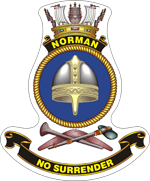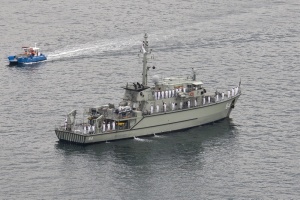HMAS Norman (II)
| Class |
Huon Class |
|---|---|
| Type |
Minehunter Coastal (MHC) |
| Role | Mine Warfare |
| Pennant |
M84 |
| International Callsign |
VLTE |
| Motto |
No Surrender |
| Builder |
ADI Newcastle |
| Launched |
3 May 1999 |
| Commissioned |
26 August 2000 |
| Decommissioned |
20 September 2018 |
| Fate |
To be sold |
| Dimensions & Displacement | |
| Displacement | 732 tonnes |
| Length | 52.5 metres |
| Beam | 9.9 metres |
| Draught | 3 metres |
| Performance | |
| Speed | 14 knots |
| Range | 1600 nautical miles |
| Complement | |
| Crew | 46 |
| Propulsion | |
| Machinery |
|
| Armament | |
| Guns | 1 x MSI DS 30B 30mm |
| Physical Countermeasures |
|
| Electronic Countermeasures | AWADI Prism |
| Radars | Kelvin Hughes 1007 |
| Sonars | GEC-Marconi Type 2093 |
| Combat Data Systems | GEC-Marconi Nautis 2M |
| Weapon Control Systems | Radamec 1400N optronic surveillance system |
| Awards | |
| Inherited Battle Honours | |
| Resources | |
| Image Gallery | |

HMAS Norman (II) was the third of six Huon Class minehunter coastal (MHC) vessels built for the Royal Australian Navy by Australian Defence Industries (ADI), Newcastle. The Huon Class was the most advanced of its type in the world. Like her sister ships, Norman was made of fibre reinforced plastic and had a unique single skin solid hull that had no ribs or frames, providing high underwater shock resistance, and very low magnetic and noise levels. This hull was designed to flex inwards if an undersea explosion occurred nearby. All machinery and equipment was mounted on cradles or suspended from bulkheads to further enhance resistance to shock damage and protect ship systems.
She was launched on 3 May 1999 by Ms Agatha Grey-Wilson, the great granddaughter of Commander William Norman, a former commander of the Victorian colonial naval forces prior to Federation, and after whom the Norman River and the town of Normanton in Far North Queensland is named. Commander Norman was the Commanding Officer of HMVS Victoria when the sloop conducted a search for the explorers Burke and Wills in the Gulf of Carpentaria in 1861.
Following sea trials which included a series of carefully controlled underwater explosions to prove her ability to withstand shocks associated with mine clearance operations, Norman commissioned into the RAN under the command of Lieutenant Commander Simon Glastonbury, RAN, at HMAS Waterhen on 26 August 2000. She put to sea two days later to immediately commence mine hunting exercises in Victorian waters. In October and November she completed a circumnavigation of Australia.
Norman was a regular participant in fleet exercises taking part in; Exercises OCEAN PROTECTOR and TANDEM THRUST in 2001; Exercises MULGOGGER and DUGONG in 2002; Exercises TASMANEX and CROCODILE in 2003; Exercise MULGOGGER in 2004; Exercises MULGOGGER and TALISMAN SABRE in 2005; Exercises MULGOGGER, TALISMAN SABRE, DUGONG and PACIFIC REACH in 2007; Exercises MULGOGGER and DAY SEAL in 2008; and a Fleet Concentration Period which concluded with a Fleet Entry and Review in 2009. She also conducted surveillance operations around the Bass Strait oil rigs in support of Operation ESTES.
She visited South East Asia on five occasions in; August/September 2002 when she participated in Exercises HUNTER and STARDEX; May to July 2003 when she took part in Exercise FLYING FISH; September/October 2005 to partake in Exercise BERSAMA LIMA; May to July 2006 when she participated in the Western Pacific Mine Counter-Measures Exercise and Exercise PENGUIN; and September to November 2008 to once again participate in Exercise BERSAMA LIMA. She visited the western South Pacific in May/June 2002 where the ship's demolition and diving teams, at the request of the Tongan Port Authority, destroyed some underwater obstructions in the main shipping channel into Nuku'alofa Harbour.
In November 2005, while returning to Sydney from her South East Asian deployment, Norman and HMAS Gascoyne conducted an unsuccessful search for the wreck of an ultralight aircraft which had crashed into the sea off Byron Bay a week earlier. The following March Norman provided support to the 2006 Commonwealth Games in Melbourne under the auspices of Operation ACOLYTE. She operated as part of the Under Water Task Group and was charged with confirming the underwater picture and identifying contacts of interest in and around the Yarra River.













